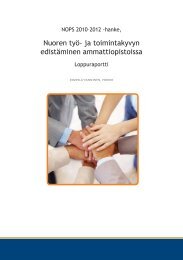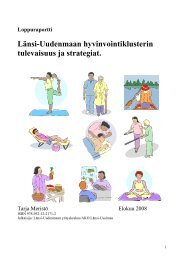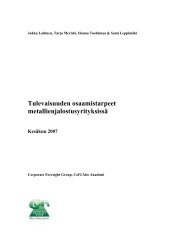- Page 1 and 2:
LAUREA PUBLICATIONS A•57 Markku N
- Page 3 and 4:
Copyright © author and Laurea Univ
- Page 5 and 6:
Foreword This publication is a comp
- Page 7 and 8:
The roots of network analysis can b
- Page 9 and 10:
Figure 1. Analytical Orientations i
- Page 11 and 12:
settings. Often the major objective
- Page 13 and 14:
Generally speaking, a grounded theo
- Page 15 and 16:
Evaluating the Limitations There ar
- Page 17 and 18:
general, the atmosphere should be e
- Page 19 and 20:
Annual NOFOMA 2005 Congress, Copenh
- Page 21 and 22:
ers. A triad is the smallest net th
- Page 23 and 24:
works. The term common carrier has,
- Page 25 and 26:
Coupling the infrastructural analys
- Page 27 and 28:
markets and hierarchies linked to g
- Page 29 and 30:
Concluding Discussion Modern logist
- Page 31 and 32:
Capineri, C.-Kamann, D -J.(1998) Sy
- Page 33 and 34:
Nikkanen, M.(2000) Comparing Networ
- Page 35 and 36:
Essay 1 Creation of Networks throug
- Page 37 and 38:
When interacting, the parties have
- Page 39 and 40:
other party are required (for more
- Page 41 and 42:
thiness gradually, first by awarene
- Page 43 and 44:
Figure 1. The Interactive Processes
- Page 45 and 46:
Furthermore, Holmlund (1996) has ca
- Page 47 and 48:
as most of the members of the netwo
- Page 49 and 50:
Conclusions One of the most importa
- Page 51 and 52:
Ford, D.- Håkanson, H.-Johanson, J
- Page 53 and 54:
Salmi, A. (1995) Institutionally Ch
- Page 55 and 56:
terfirm cohesion is under scrutiny,
- Page 57 and 58:
paradigm the examination relies mor
- Page 59 and 60:
With respect to scientific analysis
- Page 61 and 62:
smaller units of the entire supply
- Page 63 and 64:
Researchers Role Interpretative, an
- Page 65 and 66:
ing illustration depicts graphicall
- Page 67 and 68:
analytical implications derived fro
- Page 69 and 70:
Nikkanen, M.,2003a, The Role of the
- Page 71 and 72:
transportation has been conventiona
- Page 73 and 74:
Among scientists in logistics there
- Page 75 and 76:
1998). This is due to the fact that
- Page 77 and 78:
(exchange) relationship and how muc
- Page 79 and 80:
changing in time, which refers to e
- Page 81 and 82:
What comes to roles in particular,
- Page 83 and 84:
Integrator Particularly, the role o
- Page 85 and 86:
flection of the network identity. D
- Page 87 and 88:
Dissertation, University of Oulu, A
- Page 89 and 90:
---- (1996b) The Network Approach i
- Page 91 and 92:
Introduction Intermodalism (IM) or
- Page 93 and 94:
Approaching Intermodal Freight Tran
- Page 95 and 96:
poral aspect of the concept, and em
- Page 97 and 98:
it rejects partly the question of e
- Page 99 and 100:
Empirical Evidence: Case VR Cargo R
- Page 101 and 102:
Identification of Roles In order to
- Page 103 and 104:
The role of the common carrier is a
- Page 105 and 106:
also trail runs for a new wagon typ
- Page 107 and 108:
tia influence the strategic decisio
- Page 109 and 110:
Nohria,N. (1992) Is a network persp
- Page 111 and 112:
trary’; there is no single object
- Page 113 and 114:
Figure 1: Network Structures Networ
- Page 115 and 116:
and psychological proximity; close
- Page 117 and 118:
sources and resource dependencies a
- Page 119 and 120:
creating collective identity (cogni
- Page 121 and 122:
nets as well. In the focal nets cre
- Page 123 and 124: volvement of an integrator is incre
- Page 125 and 126: Havila, V.,1996. International Busi
- Page 127 and 128: Essay 6 Dealing with the Negative E
- Page 129 and 130: obliged to work in a closer manner.
- Page 131 and 132: Conflicts and power Many of the und
- Page 133 and 134: fore the network reactions (transmi
- Page 135 and 136: Conflict resolution in IFT Because
- Page 137 and 138: Scope of behavioural responses In I
- Page 139 and 140: Extending the explanation with co-c
- Page 141 and 142: Conclusions In tightly bonded netwo
- Page 143 and 144: Jary,J.and Jary,J. (1999) Dictionar
- Page 145 and 146: (e.g. destruction and annihilation,
- Page 147 and 148: Everything undergoes development an
- Page 149 and 150: However, the theory is based on the
- Page 151 and 152: The depth of the relationship and i
- Page 153 and 154: eral success, some other actors per
- Page 155 and 156: References Andersson, J.,Håkanson,
- Page 157 and 158: Essay 8 Spatial Concerns in Logisti
- Page 159 and 160: time space logistics theory social
- Page 161 and 162: tool for studying the proximity bet
- Page 163 and 164: sic elements of Piaget’s theory).
- Page 165 and 166: In general, the adoption of new beh
- Page 167 and 168: are often reinforced by closeness,
- Page 169 and 170: APPENDIX 1 Newtonian-based Interpre
- Page 171 and 172: Introduction The term common carrie
- Page 173: predictable organisational behaviou
- Page 177 and 178: lated that both the stability and d
- Page 179 and 180: (because often imbalance in contain
- Page 181 and 182: others. This means that all activit
- Page 183 and 184: Normative Approach and Interpretati
- Page 185 and 186: tions are primarily in focus (compa
- Page 187 and 188: Repositioning The discussion indica
- Page 189 and 190: ole of the common carrier. In liner
- Page 191 and 192: Ford, D.,Gadde, L-E.,Håkanson,H.,L
- Page 193: There has been growing interest rec








